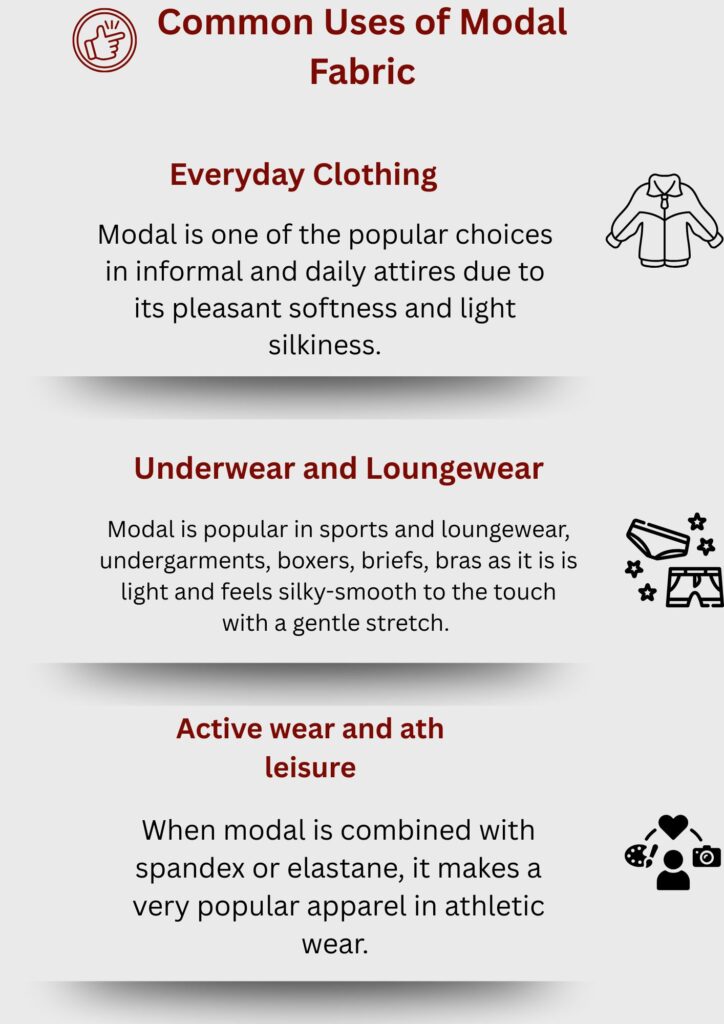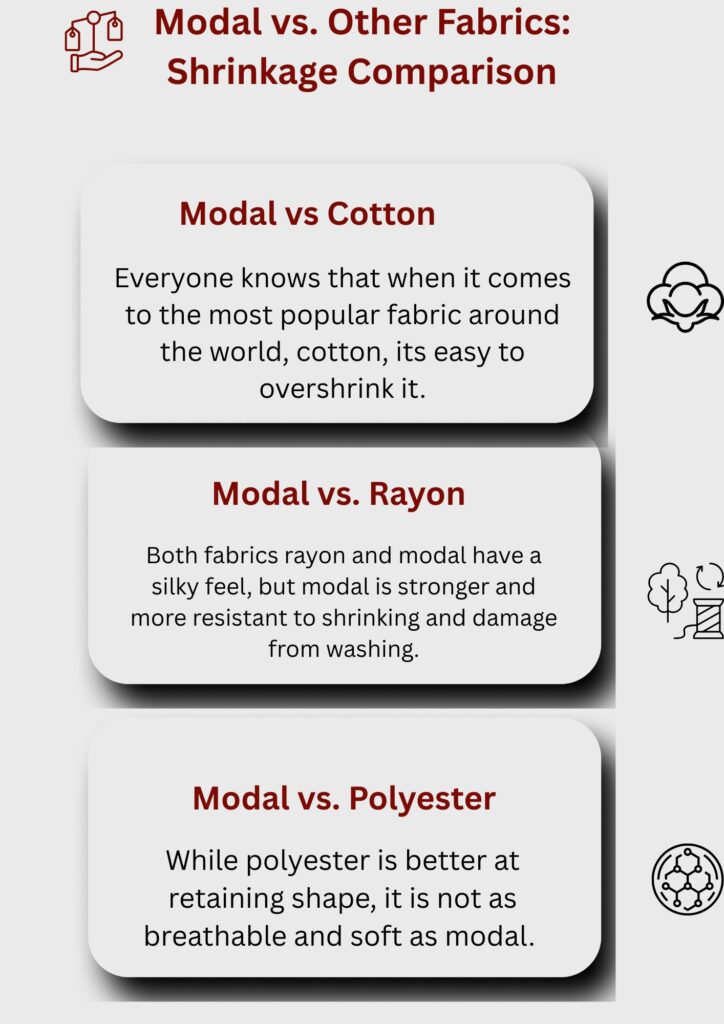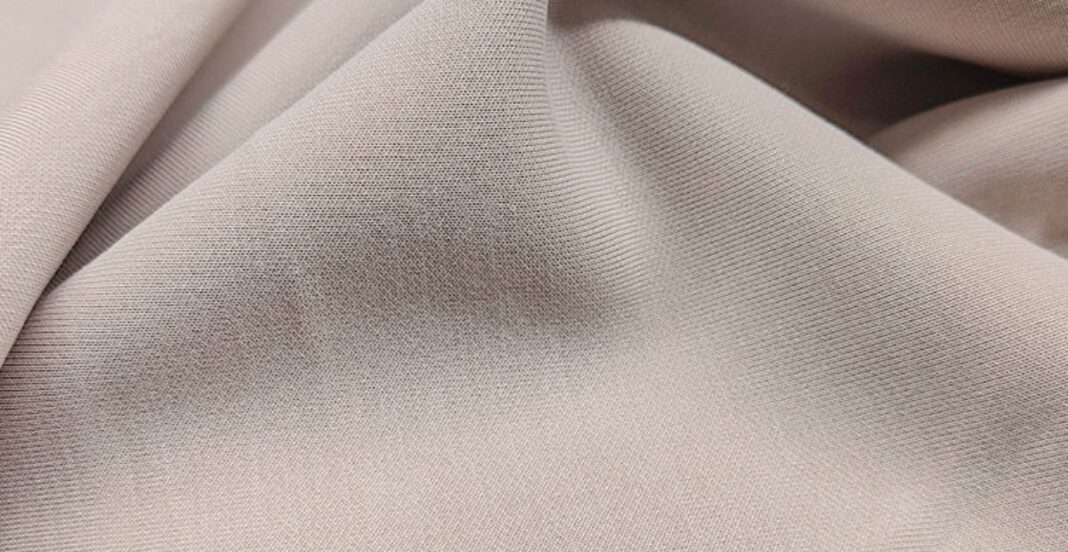Introduction
Modal fabric comes from the semi-synthetic textile which is derived from the pulp of beech trees. This fabric is an innovative achievement of the rayon family, as it is soft, eco friendly and more durable. Modal fabric is manufactured with closed-loop chemical systems which is less impactful on the environment.
In contrast with fully synthetic fabrics, such as polyester, modal comes from a natural source . Modal blends nature with science, offering the uniqueness of its silky and breathable texture, alongside being pilling resistant. Modal fabrics are perfect for people who favor combination of comfort and a touch of luxury.
Comparison with Other Fabrics
In comparison with traditional cotton, rayon and polyester, modal stands out. Cotton, whilst natural, is prone to shrinkage and wrinkling. Rayon has a softness comparable to modal, but it is neither as durable nor as shape-retaining. Polyester is synthetic, and whilst it does not shrink, it does not breathe well.
Common Uses of Modal Fabric
Due to its luxurious feel and strong performance, modal is Widely used in high-end clothing like t-shirts, leggings, and loungewear in addition to underwear. Modal’s performance in moisture-wicking and cooling makes it common for bedding products as well, including any covers for pillows and other sleep-related items.

Everyday Clothing
Modal is one of the popular choices in informal and daily attires due to its pleasant softness and light silkiness. It is also very common in t-shirts, blouses, dresses, leggings and camisoles. It is lightweight and wicks away moisture which is why it is ideal as a daily use shirt.
As compared to cotton, modal has a low percentage of shrinking and attaining shape. This makes it a durable cloth on which to use clothes that have a lot of washing.
Underwear and Loungewear
Modal is popular in sports and loungewear, undergarments, boxers, briefs, bras as it is is light and feels silky-smooth to the touch with a gentle stretch. It is comfortable on the skin hence very appropriate on sensitive parts of the body.
As modal fabric does not shrink, underwear made using the material maintains its size longer than underwear made using cotton.
Active wear and ath leisure
When modal is combined with spandex or elastane, it makes a very popular apparel in athletic wear. It finds application in yoga pants, gym tops, sports bras, and joggers, which is due to the moisture-wicking and flexible properties.
Modal is also favourite of fitness enthusiasts since it maintains shape without being hot and sweaty during a workout. In addition, most of the issues such as does modal fabric shrink are few when handling with care.
Does Modal Fabric Shrink? (Direct Answer)
Under certain circumstances modal fabrics shrink but only in certain conditions. Modal as a fiber is more resilient than cotton fabrics, and in most cases does not require heavy maintenance.
The fabric remains stable when washed in cool or lukewarm water and dried gently. However modal fabrics do not do well under high temp situations such as high temp dryers or hot water, leading to damage and shrink. A little understanding about which garments require careful maintenance can ensure you preserve your modal garments for longer.
Factors That Affect Shrinkage
There are a few considerations that impact whether modal shrinks. The most critical ones are water temperature, drying heat, and the handling of the fabric. Aggressive wash cycles and fabric twisting can also contribute to the likelihood of shrinkage.
Even with the instruction modal is easier to take care of and does not shrink as much as other fabrics, if proper care does not follow, performance will be compromised. The positive side is: with proper care, the damage is no more than minimal.
How Much Does Modal Fabric Shrink?
Modal fabric in most cases, will not shrink more than 1 to 3% and with the right conditions, remains with minimal shrinkage. While this amount is too small to affect day to day use, shrinking is not as automatic as drying. Separately, high heat during drying will trigger greater shrinkage of up to 5% and beyond.
Comparison with Cotton and Rayon
Cotton, as an example, does not perform as well with modal. It is easier to shrink when subjected to heat, and high temperatures during drying is the known enemy of cotton fabrics with up to 10% shrinkage through the first wash. Rayon is softer as modal but shrinks more semi-randomly, losing durability when wet.
Elastane-fortified modal maintains its shape more than other fabrics through repeated washings and care, and remains a trusted fabric over the years. In this case, the low shrinkage is a definite strength in value for longterm use.
Factors That Cause Modal Fabric to Shrink
Even though modal has its advantages, the fabric can shrink “twist” easily. This shrinkage can happen because of the following factors.
Using hot water
Using hot water can encourage the modal fibers to contract, thus causing warp, shrink, or twist. Because of the declining strength of modal fabric in hot water, it is advised to use cold or lukewarm water. Also, always check the label of the garment.
Tumble using High Heat
High dryer heats are a major ontario canada cause of shrinkage of modal fabric. It is imperative to remember that extensive heat can easily destroy fibers and warp shape. Instead of using the dryer, remember to air dry your clothes so that its structure can be maintained.
Poor Quality Modal Blends
Not all modal are created equally. Some garments are blended with lower quality fibers that are more prone to stumbling. Find for fabrics that are of quality, for example premium modal or TENCEL™ Modal, since their enduring strength and performance are better.
How to Prevent Modal Fabric from Shrinking
Protecting against shrinkage is easy to do if you adopt some simple practices. These habits will protect your clothes and increase their lifespan.
Wash in Cold Water or Lukewarm Water
Modal fibers respond well to cool and lukewarm water. Cold water helps to retain the fabric’s shape, texture, and color. Always avoid hot water.
Use Gentle Cycle and Mild Detergent
Washing the fabric using harsh detergents and rough cycles can weaken the delicate fibers, so use soft detergents. Go for gentle or delicate cycles and try eco-friendly mild detergents to keep the clothes soft.
Air Dry or Use Low Heat Drying Settings
Air drying garments flat remains the best drying method. If the dryer is a must, select the lowest heat option. This is effective for preventing shrinkage.
Avoid Twisting or Wringing Modal Fabric
Wringing modal will distort the shape and stretch the fabric unevenly. Instead, gently roll the fabric in a towel to soak up the water.
Iron on Low Heat If Needed
Modal does not crease easily but if you do need to iron, keep to low heat and iron the garment inside out to protect from shine and fiber damage.
How to Unshrink Modal Fabric (If It Happens)
Over time, workers or laundry attendants may accidentally overshrink clothes. Fortunately, there are methods to unshrink modal fabric.
Soak in Lukewarm Water with Conditioner
Take a basin, fill it with lukewarm water, and add baby shampoo or hair conditioner to it. Afterwards, soak the fabric in the mixture for around 15–20 minutes so that the conditioner can loosen the modal’s fibers.
Gently Pull Into Shape While Damp
After the modal’s soak, rinse away extra water without wringing it and lay flat for drying. Pull and reshape the modal to its original size gradually, ensuring to take it easy. Too much stretching may damage the fabric, so be sure to work slowly.
Reshape and Air Dry Flat
After you have achieved a satisfactory shape, leave the modal in an airy place to dry away from the sun. If the modal is hung, it can dry in an uneven shape which might further damage the fabric’s intended look. While this is a somewhat effective method of unshaping clothes, it does take time to show results.
Modal vs. Other Fabrics: Shrinkage Comparison
Comparing modal with other materials help in understanding its advantages and disadvantages. For now, we will compare modal with some of its common alternatives.

Modal vs Cotton
Everyone knows that when it comes to the most popular fabric around the world, cotton, its easy to overshrink it. Thankfully, with modal fabric, that problem will never bother you. With modal, clothes will be fitted and will last you much longer.
Modal vs. Rayon
Both fabrics rayon and modal have a silky feel, but modal is stronger and more resistant to shrinking and damage from washing. Conversely, rayon is more prone to wet weakening and shrinkage.
Modal vs. Polyester
While polyester is better at retaining shape, it is not as breathable and soft as modal. Taking care of modal more provides comfort and makes it resistant to shrinkage.
Common Myths About Shrinkage of Modal Fabric
There are several misconceptions centered around modal fiber and its attribute of shrinkage. In the following short paragraphs, these confusion are clarified.
“Modal Never Shrinks”
This is false. People have the misconception that modal is completely shrink-proof. Although its better at resisting shrinkage that a number of fabrics does, the use of high temperatures on it can cause it to shrink.
“All Plant-Based Fabrics Shrink the Same”
This is not true. Modal is a plant-based fiber like cotton or rayon but its manufacturing technology provides more stability to shrinkage. To give an example, cotton shrinks much more than modal, especially under high temperatures.
Best Practices for Caring & Washing Modal Fabric
Having a consistent care routine for modal items helps preserve softness and maintain shape for many years.
Step-By-Step Washing Instructions
- Wash the garment from the inside out.
- Cold or lukewarm water is recommended.
- Choose the gentle or delicate setting.
- Use a mild detergent.
- Do not use bleach or fabric softeners.
- Drying and Ironing Recommendations
Drying and Ironing Tips
Air drying is the preferred method. If using a dryer, select the no heat or low heat option. Use the lowest setting on the iron if ironing is necessary and avoid using it whenever possible, as it creates an added heat risk.
Storing Modal Garments Properly
Like other types of fabric, modal garments should be kept in a cool, dry place. When storing garments, folding is preferred especially for delicate pieces and stretchy garments to avoid distortion.
Conclusion
Does modal fabric shrink? The answer is no, but with protective measures like mild temperatures, air drying, and gentle wash cycles, modal garments can be preserved.
To keep garments soft, shrink-free, and well-maintained, steer clear of high dryer temperatures and hot water. Modals are more reliable than cotton and rayon, but still require attention in order to preserve and maintain appearance.
Caring for modal garments, or shopping for new clothes, these strategies are designed to help ensure the garments are preserved.


